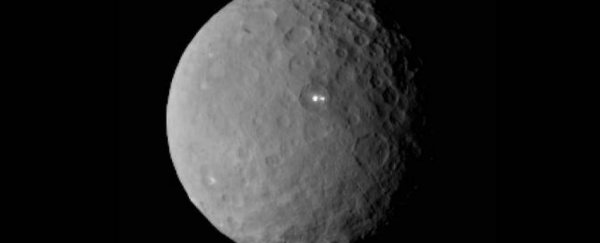NASA's Dawn spacecraft is en route to Ceres, the largest object in the asteroid belt of our Solar System, and it's spotted two strange, shiny patches on its crater-pocked surface.
Set to enter the orbit of the Ceres dwarf planet on 6 March - which just might see it reclassified as a full-on planet, along with Pluto - the Dawn spacecraft captured images of the bright spots at about 46,000 kilometres (29,000 miles) away. The brightest of the pair appears to be reflecting at least 40 percent of the light that falls on it.
"Ceres' bright spot can now be seen to have a companion of lesser brightness, but apparently in the same basin. This may be pointing to a volcano-like origin of the spots, but we will have to wait for better resolution before we can make such geologic interpretations," Chris Russell, principal investigator for the Dawn mission, said in a press release. "We knew from Hubble observations that there was variation in the colouration and reflectivity of the surface. But when we got to Ceres we saw bright spots, and they are really, really bright."
While the team isn't exactly sure what these bright patches are, what we do know is that Ceres contains a lot of water. Scientists have estimated that below the surface, it likely contains more fresh water than we do here on Earth, some of which has been detected erupting from its surface via geyser-like plumes of icy vapour. So perhaps, says Ian Sample at The Guardian, when Ceres collided with another planetary body in the astroid belt, such as Mars or Jupiter, the crash chipped away at the rocky surface to expose two little patches of the shiny, icy layer beneath. Or perhaps one of those volcanoes erupted the face right off Ceres in those two spots.
"Patches of ice should reflect nearly all of the light that falls on them, but the discrepancy could be due to the Dawn spacecraft being too far from its target to see the spots clearly," says Sample. "As it closes in, the patches could be revealed as smaller and much brighter."
Just last week, Mars dished up its own little surface mystery in the form of 250 km-tall 'clouds' that were pictured towering over its surface. And now we have weird reflecting patches on Ceres. Keep being your strange, mysterious self, space. It's why we love you so much.
Source: The Guardian
